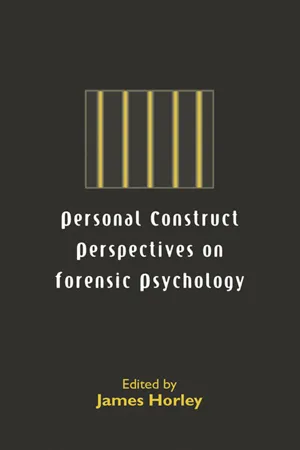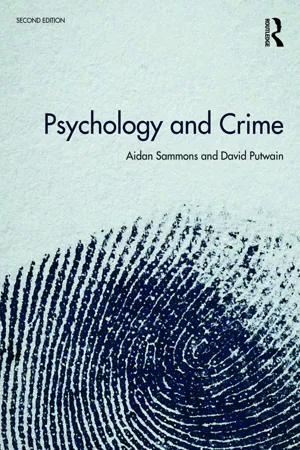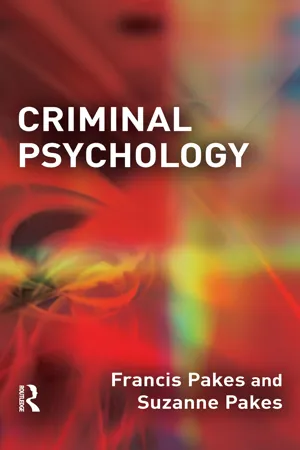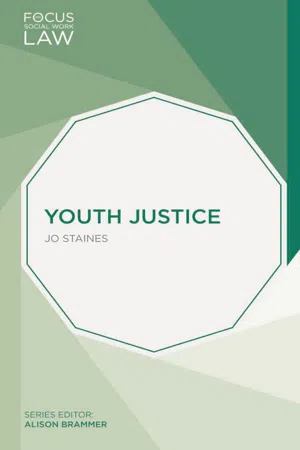Custodial Sentencing
Custodial sentencing refers to the imposition of a prison sentence as punishment for a criminal offense. It involves the confinement of the offender within a correctional facility for a specified period of time. Custodial sentencing is intended to serve as a deterrent and to protect society from individuals who have committed serious crimes.
5 Key excerpts on "Custodial Sentencing"
- James Horley, James Horley(Authors)
- 2004(Publication Date)
- Routledge(Publisher)
...Chapter 7 Psychological treatment of offenders in institutions James Horley and Lody Bennett Individuals who are charged and convicted of crimes generally enter the criminal justice system with a disposition involving probation. Contrary to common assumptions, the majority of adjudicated criminal offenders do not receive a custodial prison sentence. In addition, only a very small minority of individuals charged with a criminal offence are detained for any length of time in forensic psychiatric facilities after being found not criminally responsible for their actions, which, of course, means that they are not criminal offenders although they may well be dangerous individuals who require institutional confinement and treatment. Incarceration of offenders can serve to control reoffending or recidivism temporarily through incapacitation. Supervision, too, can limit recidivism. Incarceration and supervision are intended as deterrence by punishment. Previous examination of the psychological literature regarding criminal conduct indicates that punishment without rehabilitation does not reduce reoffence rates (Andrews, Zinger, Hoge, Bonta, Gendreau & Cullen, 1990). In the United States, approximately two-thirds of offenders released from state prisons are rearrested within three years (Henning & Frueh, 1996), and only a small percentage have been provided with any form of therapy. Psychological change through some form of treatment appears necessary to reduce criminal reoffence. Appropriate psychological treatment of offenders in institutions has the potential to assist offenders and to reduce the number of victims of crime. This chapter will examine the use of psychological treatment within forensic institutions. Types of treatment, treatment efficacy, and special issues regarding treatment of offenders will be considered. Types and efficacy of treatment The history of psychological treatment of offenders in institutions is relatively brief...
- eBook - ePub
Psychology and Crime
2nd edition
- Aidan Sammons, David Putwain(Authors)
- 2018(Publication Date)
- Routledge(Publisher)
...Imprisonment is the most serious sanction available in most Western democracies but its use varies widely. In the UK and US, there was a substantial growth in imprisonment between the 1940s and the present day. Prison serves a number of functions including retribution, incapacitation, deterrence and reform of the offender. Although it is painful for the offender in a number of ways and may affect her physical, psychological and social wellbeing, there is little evidence to suggest that it reforms criminals and some that suggests it makes offending worse. However, it does incapacitate offenders for the duration of their sentence and is a necessary measure in the case of those who pose a significant risk to society. Imprisonment is comparatively costly and there are economic arguments for avoiding it in favour of non-custodial sentences when the risk to the public is low. Non-custodial sentences include fines and community sentences. Fines have advantages in that they do not disrupt the offender’s life in the same way as prison and they may generate revenue for the authorities. The evidence for their effectiveness is not strong, although they do have a deterrent effect on some offences. Community sentences involve releasing an offender into society but imposing requirements (e.g. community service) or restrictions (e.g. a curfew) on her, under threat of more serious sanctions. Evidence suggests that those who serve community sentences have a lower recidivism rate than those who are imprisoned and there are substantial monetary savings. Restorative justice involves offenders, victims and other stakeholders voluntarily devising ways for offenders to repair the harm they have caused. It appears to produce better outcomes than conventional justice both in terms of recidivism and victim satisfaction...
- eBook - ePub
- Andrew Ashworth, Rory Kelly(Authors)
- 2021(Publication Date)
- Hart Publishing(Publisher)
...7 Custodial Sentencing 7.1. The State of the Prisons 7.2. The Use of Imprisonment 7.3. Principles for the Use of Custodial Sentences 7.4. On the Cusp of Custody 7.5. Medium-to-Long Custodial Sentences: Release on Licence 7.6. Long Custodial Sentences 7.7. Conclusions This chapter presents a critical appraisal of the law and practice on custodial sentences. Imprisonment involves deprivation of liberty and is the most onerous and intrusive sentence available in this and other European countries. Incarceration in a punitive institution requires special justification. Incarceration in the particular conditions prevailing in the prisons of England and Wales calls for strong justifications, especially in relation to the rights declared in the European Convention on Human Rights. In order to determine what needs justification, it is necessary to understand the practical meaning of custodial sentences. This depends on the various provisions for calculating the proportion of the nominal sentence that the offender will spend in custody, on the conditions in which prisoners are held, and on the terms on which they are later released. While the sentence handed down in court establishes the framework, there are exercises of discretion in the prisons and by the Parole Board that have powerful effects in determining the time actually served. 1 The chapter begins with an outline of the state of English prisons, a key factor in what must be justified. It then considers principles and policies for the use of custodial sentences, and moves on to an analysis of the statutory tests for imposing custody, and also the prevailing approach to long custodial sentences. 7.1. The State of the Prisons ‘We saw once more in 2018–19 … that far too many of our jails have been plagued by drugs, violence, appalling living conditions and a lack of access to rehabilitative activity’...
- eBook - ePub
- Francis Pakes, Suzanne Pakes(Authors)
- 2012(Publication Date)
- Willan(Publisher)
...Chapter 5 Sentencing and punishment In Chapter 1 we saw that there are over 10 million crimes committed in England and Wales each year. Currently the prison system holds just over 80,000 inmates. From comparing those two statistics one conclusion can be drawn: most offenders are not in prison. We have seen that most crimes are never prosecuted. But in addition, community sentences and fines are imposed much more frequently than prison sentences. In this chapter we shall first examine the process of sentencing. After that we shall look at the implementation of sentences which we call punishment. Punishment is an emotive term. It implies the infliction of harm. Indeed, that is part of the reason why punishment is imposed. But it not the only or even the prevailing reason. Other factors that come into play include rehabilitation, which is based on the idea that offenders can be changed, and that those changes will reduce the chance of reoffending. A further consideration is public protection. When we take an offender out of the community, that community will no longer be at risk of the offending behaviour of that individual. Sentencing Most of the time, a sentence is imposed with several reasons in mind. A judge might send a violent offender to prison because that sentence corresponds to a tariff. That means that a prison sentence is the ‘going rate’ for that offence. In addition, a judge might decide that whilst in prison, the offender should undertake either counselling or training. Such skills might decrease the likelihood of reoffending. Finally, a judge might decide that the needs of the victim are best served with a particular sentence. Apart from prison a judge has a range of sentencing options. We make a distinction between three types of sentences. The first is prison, or detention, often called custodial sentences. The second comprises community sentences which most of the time are community orders. They can involve a variety of activities...
- eBook - ePub
- Jo Staines(Author)
- 2015(Publication Date)
- Bloomsbury Academic(Publisher)
...Labelling theory (Becker, 1963) demonstrates how being sentenced to custody can be stigmatizing and often has negative consequences for young people once they have been released, in terms of finding employment and accommodation, particularly as they will have an ‘active’ criminal record for a minimum of 18 months post-release. As a result, almost three-quarters (73 per cent) of young people released from custody reoffend within a year of their release, compared with 68 per cent of those who receive a YRO and 45 per cent of those who received other community sentences (MoJ, 2013a). It is thus essential to continue the reduction in the youth justice population and, for those who remain within the juvenile secure estate, to improve the conditions therein, both to ensure that their rights are not breached and to maximize rehabilitation and minimize recidivism. The discrimination apparent against girls and some minority ethnic groups, both at the point of sentencing and during the custodial period itself, needs to be addressed, and the particular needs of those children serving long-term sentences warrant detailed consideration. Any period of custody risks breaching children and young people’s rights and a custodial sentence, be it short or long-term, can only be justified if it does offer a valid opportunity for rehabilitation and positive reintegration after release, and if the welfare of the child is prioritized...




